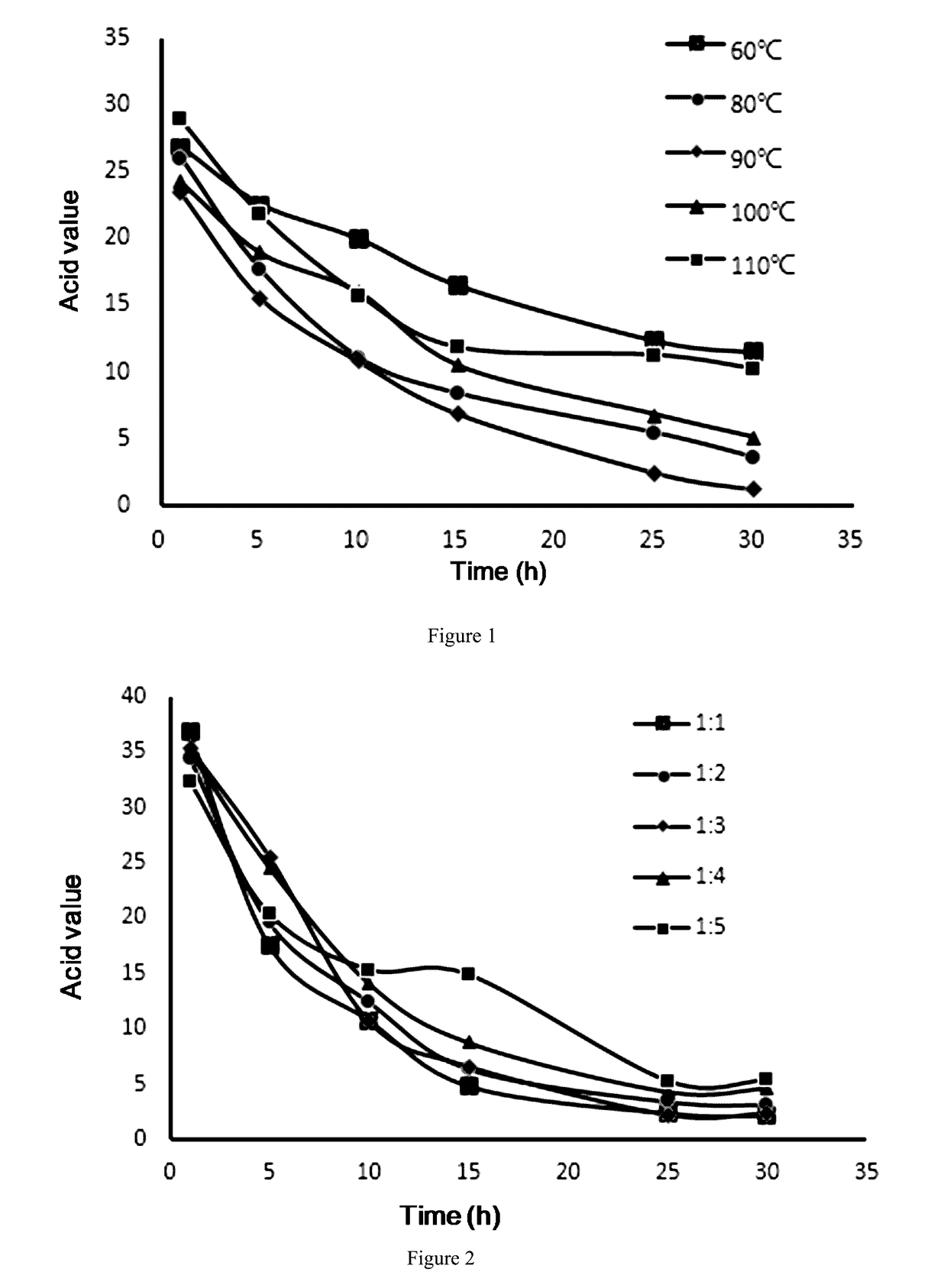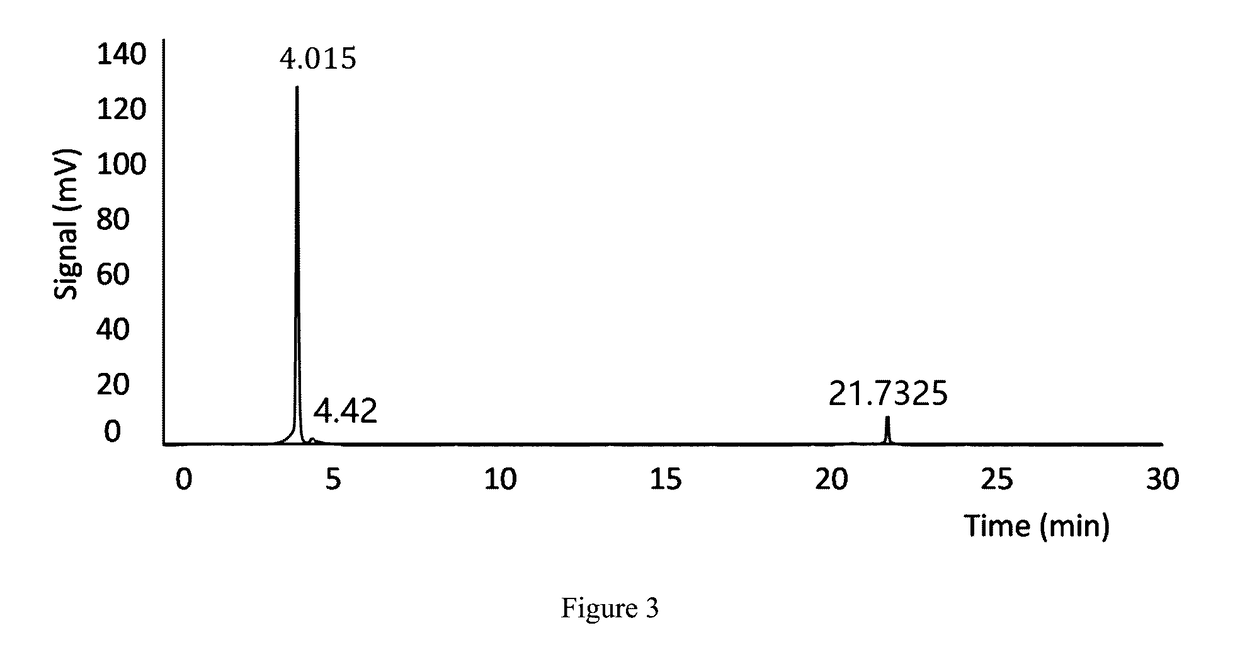Method for Vegetable Oil Deacidification by Enzymatic Amidation
- Summary
- Abstract
- Description
- Claims
- Application Information
AI Technical Summary
Benefits of technology
Problems solved by technology
Method used
Image
Examples
example 1
[0022]Intermittent enzyme reaction was carried out in a batch stirred tank reactor, the free fatty acids and ethanolamine was mixed at a molar ratio of 1:1-5 (acid value of high acid rice bran oil is 40.8 mg KOH / g), thehigh acid value vegetable oil mixing with hexane at 1:2 (w / v), 5% molecular sieves of 4A and 4% immobilized lipase Lipozyme 435 was added. The system was stirred at 90° C. under normal pressure for a certain time, and then centrifuged under 4000 r / min for 10 min to remove molecular sieve, fatty acid monoethanolamine and unreacted monoethanolamine Subsequently rotary evaporation was used to evaporate hexane under 0.085 Mpa, at 75° C. The vegetable oil possessed low acid value (according to GB 5530-85, the same as below) was harvest in hexane that been condensed in the condenser. It can be seen in FIG. 1, with the increase of time, the acid value of oil reduced, and the deacidification effect enhanced, with the increasing molar ratio of monoethanolamine with free fatty ...
example 2
[0023]Intermittent enzyme reaction was carried out in a batch stirred tank reactor, the free fatty acids and ethanolamine was mixed at a molar ratio of 1:1 (acid value of high acid rice bran oil is 34.5 mg KOH / g), the high acid value vegetable oil mixing with petroleum ether at 1:2 (w / v), 5% molecular sieves of 4A, and 6% immobilized lipase of Lipozyme TL IM was added, the system was stirred at different temperatures under normal pressure for a certain time, and then centrifuged under 4000 r / min for 10 min to remove the lipase, molecular sieve, fatty acid monoethanolamine and unreacted monoethanolaminen, subsequently rotary evaporation was used to evaporate petroleum ether under 0.085 Mpa at 75° C. The vegetable prossessed low acid value was harvest in petroleum ether that been condensed in the condenser. It can be seen in FIG. 2, with the increase of time the acid value of oil reduced, and the deacidification effect was enhanced. The reaction temperature significantly influenced th...
example 3
[0024]Intermittent enzyme reaction was carried out in a batch stirred tank reactor, the free fatty acids and ethanolamine was mixed at a molar ratio of 1:1 (acid value of high acid rice bran oil is 31.8 mg KOH / g), the high acid value vegetable oil mixing with ethyl acetate at 1:3 (w / v), 5% molecular sieves of 4A, and 6% immobilized lipase of Lipozyme RM IM was added, The system was stirred at 60° C. for 20 h under normal pressure, and then centrifuged at 4000 r / min for 10 min to remove the lipase, molecular sieve, fatty acid monoethanolamine and unreacted monoethanolamine After that, rotary evaporator was used to evaporate the ethyl acetate under 0.085 Mpa at 75° C. The vegetable oil possessed low acid value (3.05 mg KOH / g) was harvest in ethyl acetate that been condensed in the condense. The normal phase HPLC chromatogram of the reaction product is shown in FIG. 3, the wherein retention time at 4.015 min, 4.42 min and 21.7325 min was rice bran oil triglycerides, fatty acids and fat...
PUM
 Login to View More
Login to View More Abstract
Description
Claims
Application Information
 Login to View More
Login to View More - R&D
- Intellectual Property
- Life Sciences
- Materials
- Tech Scout
- Unparalleled Data Quality
- Higher Quality Content
- 60% Fewer Hallucinations
Browse by: Latest US Patents, China's latest patents, Technical Efficacy Thesaurus, Application Domain, Technology Topic, Popular Technical Reports.
© 2025 PatSnap. All rights reserved.Legal|Privacy policy|Modern Slavery Act Transparency Statement|Sitemap|About US| Contact US: help@patsnap.com


